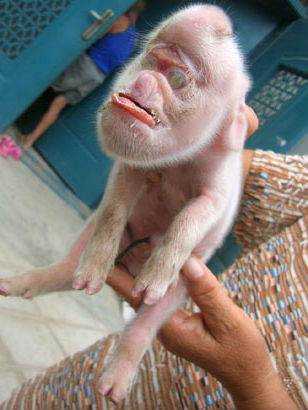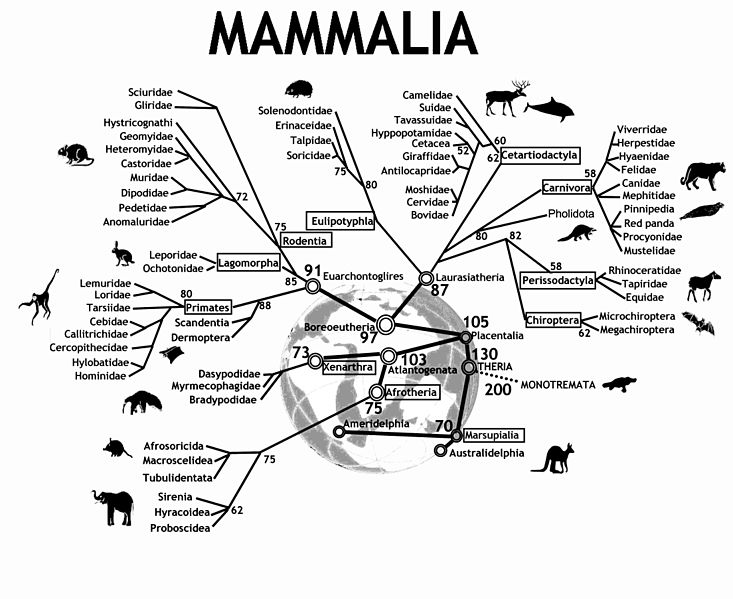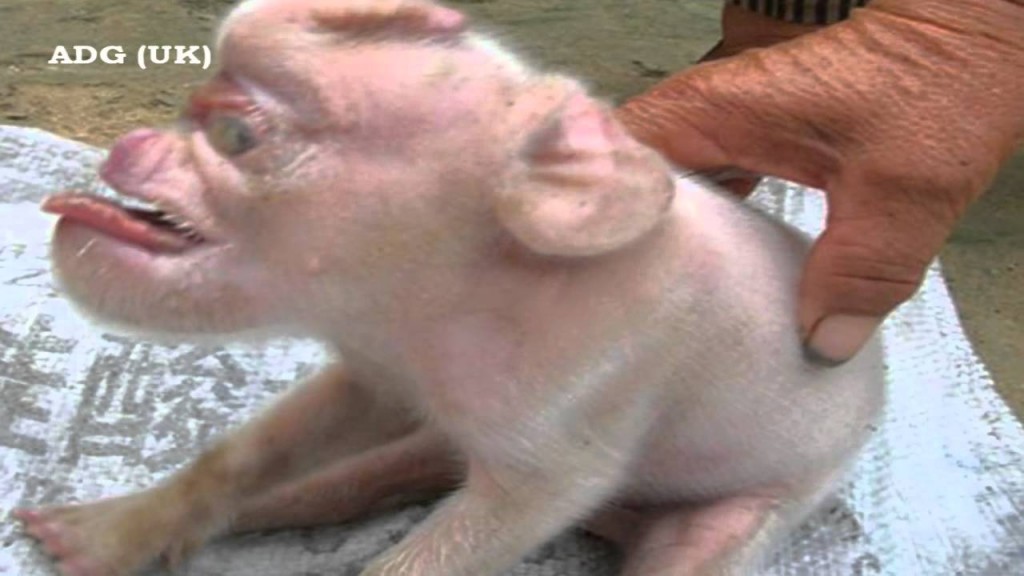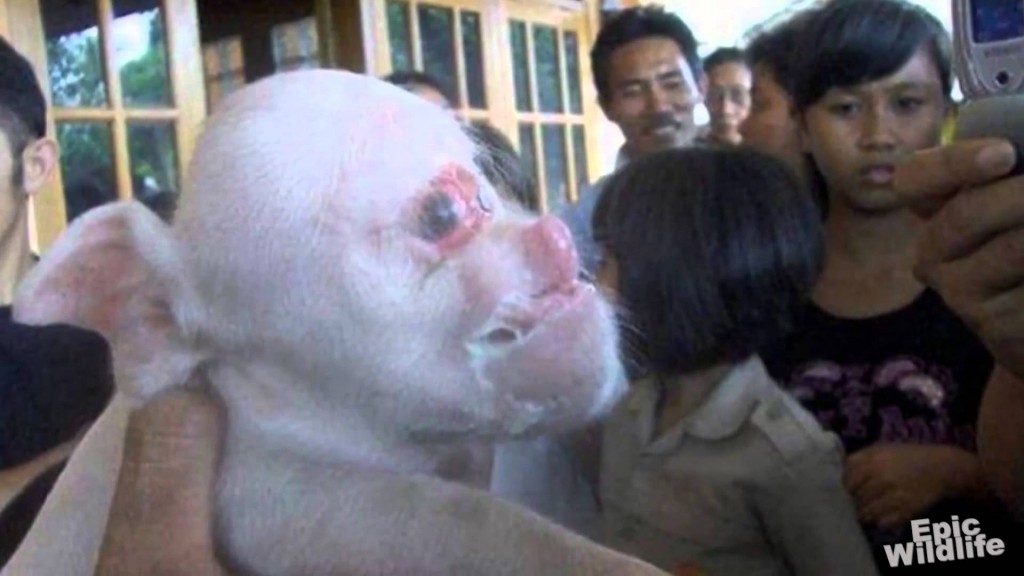
I recently became aware of a hybridization theory of human origins. The science news website phys.org has had two different articles on this topic (see here and here). The proponent of this theory is Dr. Gene McCarthy, a geneticist trained at the University of Georgia. In short, McCarthy hypothesizes that humans resulted from a hybridization event between a chimp-like human ancestor and a pig-like ancestor with subsequent back-crosses to the chimp-like ancestor. That is, once the initial small number of hybridizations occurred, the hybrids only paired with the chimp-like ancestor subsequently. Therefore, according to this theory, humans would be mostly primate with a smattering of pig genes interspersed through the genome. This small band of hybrids would then have reproduced prodigiously and thus the human species formed.
Though the idea sounds completely insane, McCarthy offers a fair amount of morphological evidence which I am not especially qualified to evaluate. You can look at this on his site, the first link above. He also shows various examples of crosses known to occur today which produce fertile female hybrids; albeit with reduced fertility compared to both parent species. In any event, morphological evidence in my opinion can at best compel a more detailed look at genetic data to verify, or more probably refute, the theory. It is quite possible that the morphological similarities are merely a case of convergent evolution rather than evidence of common ancestry.
However, it is known that the human species has very little genetic diversity relative to other species. It is hypothesized that early in the history of the human species there was a very constrictive bottleneck. One of the pieces of evidence used for this bottleneck is the one fewer chromosomes humans have relative to other great apes. It is much easier for a change of this sort to become fixed in a population when that population is very small. Notably, the pig genome also has fewer chromosomes and a hybridization event might explain the reduction in number of chromosomes. The chromosome number is much farther away from pigs and closer to primates, but this would be consistent with the idea that back-crosses occurred exclusively with primates. Could it be that the bottleneck, with its resultant low genetic diversity and reduction in chromosome number, is explained by a very isolated hybridization event among a small group of chimp-like ancestors? These ancestors being the founding population of all humans?
Though hybridization does happen on occasion, it is mostly only successful with plants. Natural hybridization was very important in the development of cultivated wheat for example. (See here and here and here and here). Some wheat species amazingly tolerate hexaploidy successfully. Another good case of hybrid crosses important for agriculture are the citrus fruits; many of which resulted from hybridizations. The grapefruit, for example, resulted from the hybridization of a blood orange (a variety of sweet orange) and a pomelo. I only know of one successful speciation event among animals that resulted from hybridization, and that was between two closely related dolphin species. McCarthy himself claims that hybridization of closely related species of this sort is common among birds in his book “Handbook of avian hybrids of the world,” which is apparently regarded as the preeminent publication on the subject. Here is a confirmed speciation event resulting bird hybridization that occurred on one of the Galapagos islands.. McCarthy also provides a list of other purported hybrid examples documented in the last 150 years or so. Admittedly, a number of these examples aren’t very believable or persuasive, but I will let you be the judge of that yourself. Some are obviously true though; like mules and zeedonks. (Zeedonk is an awesome name BTW)
So we know for a fact that closely related species of plants and animals can hybridize, and that they are even sometimes fertile. That is fine, but an ape and a pig are much more distantly related. Could a successful speciation event occur from such a pairing? Intuition says no, but it is better to let the evidence decide.
There is one way to be absolutely sure it did not happen, and that is through genetic comparisons. One thing that was lacking in McCarthy’s descriptions was any sort of genetic evidence, which immediately made me suspicious. Though highly incredulous, I am not closed-minded and so I dutifully wanted to check genetic studies myself to see if the theory could be positively refuted. Surely there must be some genetic evidence which could rule out this idea conclusively.
So what do we know about human and pig genome comparisons? The domestic pig genome has been sequenced, and all the studies point to it being a better model organism for Human diseases than the mouse. Quoting the author’s of one study:
“In total, we found 112 positions where the porcine protein has the same amino acid that is implicated in a disease in humans,”
In another study, the geneticists were more direct:
“Physical clone maps have underpinned large-scale genomic sequencing and enabled focused cloning efforts for many genomes. Comparative genetic maps indicate that there is more structural similarity between pig and human than, for example, mouse and human.”
Well that is surprising. Pigs make better genetic models for human diseases than rodents? Apparently there is 84% homology between the pig and human genome and critically for medical research, many of the genes implicated in human disease possess the same mutations in pigs.
At first you might not think it is weird that a pig would be a better model than a mouse, but it is actually really strange. If you look at a taxonomic tree of mammals, rodentia (mouse and rat) is very closely related to primates. This is a relatively recent split. Pigs, in the superorder Laurasiatheria and order Artiodactyla, are much farther away. In other words, the last common ancestor of pigs and humans should be much more ancient than the last common ancestor of humans and mice. Since the split is much more ancient, you would expect there to be much more dissimilarity between humans and pigs relative to humans and mice. Therefore, it makes little sense that a pig should be a better model organism at the genetic level for human diseases than the mouse. Curious indeed.

The Platypus Example
Ok, so there isn’t much on pig and human comparisons, but what is available doesn’t seem to contradict the hybridization theory and may even modestly support it. McCarthy also uses the platypus as an example of an even more distant hybridization. Clearly, this is much more distant than primates and pigs. If hybridization could be established as the correct origin of the platypus, then it reduces the implausibility in the human hybridization theory. However, even if the platypus is a hybrid that does not mean humans are. It merely makes speciation as a result of hybridization of distant species plausible.
Certainly a platypus looks like the offspring of a beaver that had sex with a duck. They also share other less obvious characteristics with both ducks and mammals as well. For example, they lay eggs like ducks and produce milk like mammals (without nipples). You can watch the documentary on the platypus below to get an idea of what it looks like, if you don’t know already.
One might object that platypus fossils have been found that are incredibly old; at least 120 million years old. You might expect that there were no ducks around that long ago. However, duck-like birds have been found as old as 110 million years old. That isn’t quite overlapping, but it suggests that it is at least possible that the relevant animals did in fact exist side by side during the necessary time frame. Considering how developed those duck-like birds are, it is possible that duck-like birds had been around for awhile at that point. Who knows? We can’t be certain until a relevant fossil is found that happens to be old enough.
There is also the problem of the mating. Would a duck actually try to have sex with a beaver or vice-versa? Anyone who has been to a duck pond regularly knows how aggressively male ducks act towards females during mating season. I have personally seen a male duck fly 20 yards across a pond at a female in the water, bite her neck, and force her completely under the water, head and all, as he finishes his business. The male duck rapes her in human parlance. On another occasion a male duck was doing something similar on land and a woman was upset enough that she actually chased him away and loudly chastised him. lol. All of this may be an example of sexism in nature. When do you think we will start legislating against duck rape culture? Anyway, this pattern of behavior has been present in water fowl for so long that female ducks have actually evolved vaginal pathways with dead ends which are meant to divert the semen of unwanted males. The male duck’s penis itself shoots out rapidly like a projectile during this process in an effort to navigate the female’s maze-like vagina. It isn’t much of a stretch that a male duck in the midst of mating frenzy might mistake any animal that happens to be splashing about in the water for a female duck and engage in his normal rape mating behavior on the unfortunate creature. Therefore, it isn’t hard to imagine this may happen from time to time and thus create the opportunity for a hybridization event. Duck-beaver matings are thus not the least plausible of things I have ever heard of. The Annunaki are much harder to believe in, for example.
[EDIT: Seals attempt to mate with penguins. While not proof of hybridization, it does show that such inter-species matings of comparable distance to that of platypus ancestors do in fact occur]
Even though it is plausible that an ancient male duck-like bird might try to rape an ancient otter or beaver-like mammal doesn’t mean hybridization might occur, though. There are much more significant barriers than mere mating behavior. The hybrid must develop, be born, and be capable itself of producing offspring. How can we know if a platypus actually is a hybrid or just a particularly strange mammal that resulted from a traditional understanding of evolution?
To answer this question, we need to know about the genetics of the platypus. If the platypus has bird ancestry, then it must have bird genetics. In writing my soon to be released book on cognitive differences between the sexes, I spent a large amount of time researching the X chromosome; including looking at studies which deal with its evolution. Unsurprisingly, the platypus X (among other things) is of special interest to evolutionary geneticists because it is supposed to be a missing link of sorts. The state of the platypus sex chromosomes is supposed to be informative on general mammalian sex chromosome evolution because scientists currently think early mammals must have resembled the platypus. I don’t really dwell on this in the book, but I did learn a few things about the platypus X. I quote this study [emphasis mine]:
“Little is known about the gene content of the 10 platypus sex chromosomes, but the few available data are extremely striking. Early comparative mapping using radioactive in situ hybridization with heterologous probes suggested that X1, located at one end of the chain, shared homology with the ancient part of the mammalian X (Watson et al. 1990; Wilcox et al. 1996; Mitchell et al. 1998; but see also Waters et al. 2005). At the other end of the chain, fluorescent in situ hybridization (FISH) of a large insert BAC-clone showed that X5 contained the Z-borne putative bird sex-determination gene DMRT1 (Grützner et al. 2004; El-Mogharbel et al. 2007). This suggested that the monotreme meiotic chain has homology with the therian XY system at one end and to the bird ZW system at the other, and represents an evolutionary link between two systems that were previously thought to have evolved independently”
“We have also tested the hypotheses that platypus sex chromosomes share homology with both the mammal XY and the bird ZW systems. In complete contradiction to early data, we find that the 10 sex chromosomes of platypus share no homology with the ancestral therian X chromosome, which is homologous to platypus chromosome 6. Instead, we find that regions homologous to the chicken Z are scattered throughout the chain, principally on X5 and X3.”
Ok, so homology is shared between bird sex chromosomes and platypus sex chromosomes and the platypus even has a bird sex determination gene. Some studies say that there is homology to the therian X, and others don’t. The bird connection is undeniable though. Fair enough, both probably derived from common ancestor chromosomes through the normal mechanisms of evolution. But wait:
“The absence of homology between the bird Z chromosome and the snake and turtle Z sex chromosomes suggests that the origin of the sex chromosomes and the causative genes of sex determination are different between birds and reptiles.”
If the X did directly evolve from an ancestral Z chromosome which is the same ancestor of the modern bird sex chromosomes, how is it that the bird Z evolved after birds split from reptiles, which would itself have occurred after mammals had split from reptiles? Why do the platypus sex chromosomes share NO homology with the chromosome that eventually became the X in all other mammals? Why would all other mammals switch from a perfectly functional sex chromosome system and start using chromosome 6 for sex determination instead? As you can see, that the platypus basically has a morphed bird sex determination system is extremely strange.

Proto-mammals (synapsids) split from reptiles (sauropsids) at a very ancient date (sometime in the Permian or Carboniferous period 250-340 million years ago). After that, in the late Permian or early Triassic, the archosaurs (which produced dinosaurs, some of which became birds) split from the parareptillia (which produced snakes). Where turtles belong relative to snakes and birds is unclear, but molecular evidence strongly suggests they are diapsids, which firmly makes them more related to birds than mammals.
For reptiles and birds that do have sex chromosomes, the evidence is clear that they evolved independently and are unrelated to each other. However, many reptiles do not have sex chromosome determination; they often use temperature or other mechanisms. Notably crocodiles use temperature for sex determination and so have no sex chromosomes at all. Crocodiles without sex determination chromosomes are more closely related to birds than snakes and turtles with sex chromosome determination. In other words, the bird Z evolved relatively long after the split not only from our mammalian ancestors, but even long after the split of birds from other more closely related reptiles. So how can a platypus share homology with birds, and not mammals, in the sex chromosomes if bird sex chromosomes evolved long after a split with mammals? Is the large body of evidence which led scientists to expect platypus sex determination systems to be completely independent of birds, since the platypus is classified as a mammal, really wrong? Why are scientists so ready to overturn everything they know about the evolution of reptile, bird, and mammal sex chromosomes (among other things) for what is seemingly a unique aberration? The idea that bird sex chromosomes evolved after the split from reptiles has not really been overturned to my knowledge. That is unless you take platypus sex chromosomes at face value, but that just creates a whole new batch of questions regarding evolution of the Z. In the case of the platypus, hybridization theory is actually more consistent with the previous scientific consensus than the retrofitted accommodation of the unique platypus sex chromosomes in the evolution of the therian X. Hybridization theory is more parsimonious because as a unique exception to the rule it does not require upending previous thinking on evolution; at least with respect to the evolution of the therian X chromosome.
Once you eliminate the impossible, whatever remains, no matter how improbable, must be the truth.
Sir Arthur Conan Doyle
If hybridization theory is true, though, then any notion that monotreme genomes tell us much about the state of early mammals must be completely disregarded. Or at least, we would have to verify if any particular gene is of mammalian or avian origin before deciding which lineage it is informative of. Also, the somewhat arrogant idea that monotremes are somehow “primitive” would also have to be thrown out. Birds lay eggs and have bills too, that does not make them evolutionarily “primitive.”
Another thing that is pretty weird about platypus sex determination is that they have a bunch of separate X and Y chromosomes. That is pretty different from both mammals and birds, and pretty much any other sex determination system I have heard of. Perhaps it is actually a snapshot of the early evolution of the bird Z chromosomes? In any event, the many sex chromosomes in the platypus does remind me of one thing though, and that is the polyploidy that is common among plant hybrids. Plants tend to be much more tolerant of polyploidy than animals, and can speciate by having complete genomes from both parent species. Just because plants are more tolerant, does not necessarily mean it is impossible in animals. Are platypuses polyploid with respect to their sex chromosomes because of a hybridization event? Strange stuff.
The end result of my research into hybridization is that most of the information pertaining to the genetics of hybridization seems to make the theory plausible, though certainly not proven. A strikingly unexpected finding on my part. If it turns out to be true that a pig-monkey hybrid event did take place at the origin of the human species, that would be a pretty big collective hit to our ego. Probably more shocking than Darwin’s original suggestion that man evolved from apes. Ironically, it would also make the south park parody of evolution/creationists factually correct after a fashion. Poe’s law would reach inception levels. A parody which everyone thought was crap actually turning out to be correct would be ironic beyond compare.
On that note, perhaps Africa is at the forefront of human evolution after all. Jokes aside, that bestiality still occurs at all today in places like Africa, Wales, and New Zealand suggests that attempts are made at inter-species mating at a common enough rate that successful hybridization events in animals might actually be possible even if they are only very rare. By “successful” I mean that fertile offspring are produced. The fact that pretty much all the ancient moral code sages felt bestiality was a common enough problem that it had to be explicitly condemned says a lot about how many of our brothers tend to be wayward. Is there any reason to think pre-human ancestors were any less wayward? I wouldn’t expect bestiality to make much of an impact on the moral conscience of pigs either. Bestiality being a common enough problem in the past suggests hybridization may be a key, if rare, feature of evolution.
In closing, I leave you with this astute observation my Aunt once made. It originally came up during a discussion about the improbable pregnancies of obese women, but it seems like it might be relevant for this situation as well.
For every pig, there is a pig fucker.
Some more hybrid pig pictures:

Disturbed Asian Girl:


I’m sure you are aware of the fertile camel x llama crossbreed known as the cama and that wolves, dogs, coyotes and dingos can all interbreed to create fertile offspring.
http://en.wikipedia.org/wiki/Cama_%28animal%29
http://en.wikipedia.org/wiki/Canid_hybrid
These would be better arguments for hybridization than the platypus as we already have a lot of information on how it works. Maybe the platypus is some bird x mammal and part of me hopes it is, but until it can be proven I’m not going to start spouting that off to friends.
I am a firm believer in hybridization because of the existence of the cama, pigs and hominids interbreeding to create humans makes some sense. It would explain why it is a trope in stories to have men transform into pigs and vice versa. We see this in a list of tales as varied as The Odyssey, Animal Farm, Willow, Brothers Grimm (prebowdlerization), the Quran, Journey to the West, South Park (which you mentioned) and H.P. Lovecraft’s The Rats in the Walls.
http://en.wikipedia.org/wiki/Pigs_in_popular_culture
Transformation is almost always horrific and irreversible and the trope is found in a wide variety of peoples, meaning that it speaks deeply to our species consciousness. I could certainly see pig x primate hybrids being a real thing.
Who wants to take bets that what makes whites unique is heavier pig admixture than other races? Also (more seriously) have you read up on neanderthal and homo sapien admixture being the reason for the existence of whites and asians? I’ve been looking to discuss this with other neoreactionaries, but have not been able to find time to write a post. Interesting stuff here:
http://www.eupedia.com/europe/neanderthal_facts_and_myths.shtml
http://www.eupedia.com/forum/threads/24893-Do-modern-Europeans-partly-descend-from-Neanderthal
http://atavisionary.com/hybridization-theory/
Eupedia genetics is generally high quality/trustworthy.